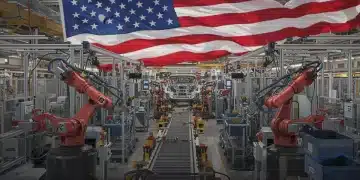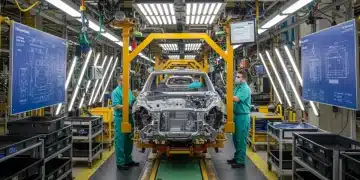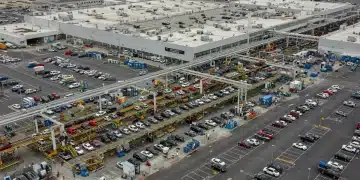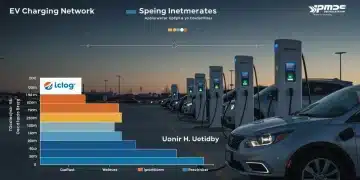IIJA Fuels US Auto Sector Growth 2025: Key Impacts
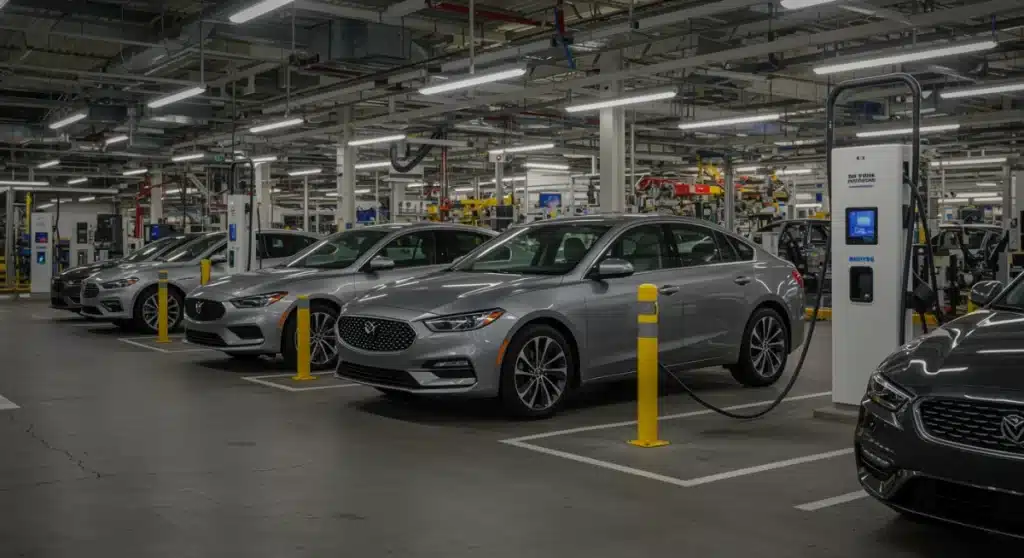
The Infrastructure Investment and Jobs Act (IIJA) is actively fueling substantial growth in the US auto sector through 2025, primarily by accelerating electric vehicle adoption, expanding charging networks, and stimulating domestic manufacturing and job creation across the nation.
Are you wondering how a landmark piece of legislation could reshape an entire industry? The Infrastructure Investment and Jobs Act is fueling US auto sector growth in 2025, marking a pivotal moment for domestic manufacturing and the future of transportation. This comprehensive act is not just about roads and bridges; it’s a strategic investment creating ripple effects throughout the automotive landscape.
Understanding the Infrastructure Investment and Jobs Act (IIJA)
The Infrastructure Investment and Jobs Act (IIJA), signed into law in November 2021, represents a monumental federal investment designed to modernize America’s infrastructure. This bipartisan legislation allocates billions of dollars across various sectors, including transportation, energy, broadband, and water systems. Its broad scope inherently impacts industries far beyond traditional infrastructure, with the automotive sector standing out as a significant beneficiary as of late 2024 and looking into 2025.
The core objective of the IIJA is to rebuild and upgrade critical infrastructure, enhancing economic competitiveness and creating jobs. For the auto industry, this translates into direct funding for electric vehicle (EV) charging networks, investments in domestic battery manufacturing, and support for advanced automotive research and development. These provisions are strategically aimed at accelerating the transition to a cleaner, more electrified transportation future, directly influencing how the US auto sector operates and innovates.
Key Pillars of IIJA Impacting Automotive
The IIJA’s influence on the automotive sector is multifaceted, touching upon several critical areas. These pillars are designed to create a robust ecosystem for future vehicle technologies and manufacturing.
- Electric Vehicle Charging Infrastructure: A significant portion of the IIJA is dedicated to establishing a national network of 500,000 EV chargers. This investment is crucial for alleviating range anxiety and accelerating consumer adoption of electric vehicles.
- Domestic Battery Manufacturing: The act includes provisions to bolster the domestic supply chain for EV batteries, reducing reliance on foreign sources and creating manufacturing jobs within the U.S.
- Public Transit Modernization: While not directly auto manufacturing, improvements to public transit systems can influence urban mobility trends, potentially impacting vehicle sales and usage patterns.
- Research and Development Funding: Support for advanced automotive technologies and sustainable manufacturing practices helps push innovation within the industry.
Accelerating Electric Vehicle Adoption and Manufacturing
One of the most immediate and profound impacts of the IIJA on the US auto sector is the rapid acceleration of electric vehicle (EV) adoption and manufacturing capabilities. The act’s substantial funding for EV charging infrastructure is dismantling one of the primary barriers to widespread EV ownership: access to reliable charging. As of Q4 2024, states are actively deploying funds, with numerous charging stations under construction or in planning stages, setting the stage for a significant increase in operational chargers by 2025.
Beyond charging, the IIJA is directly incentivizing domestic EV manufacturing. This includes not only vehicle assembly but also the critical components, particularly batteries. Several major automakers and battery manufacturers have announced new plants or expansions in the U.S., driven in part by the supportive policies and funding opportunities presented by the IIJA. This push aims to create a more resilient and localized supply chain, reducing vulnerabilities and fostering economic growth within American communities.
Boosting Domestic Battery Production
The establishment of a robust domestic battery supply chain is paramount for the long-term success of the US EV market. The IIJA provides crucial financial incentives and grants to companies willing to invest in battery cell and component manufacturing within the United States. This strategic focus is already yielding results, with new gigafactories being planned and constructed across various states.
- Supply Chain Resilience: Reducing dependence on overseas suppliers for critical battery materials and components ensures greater stability for US automakers.
- Job Creation: New battery manufacturing facilities are generating thousands of high-skilled jobs in engineering, production, and research.
- Technological Advancement: Domestic production fosters innovation in battery technology, leading to more efficient, safer, and longer-lasting EV batteries.
Job Creation and Economic Impact Across the Nation
The financial injections from the Infrastructure Investment and Jobs Act are translating directly into significant job creation and broad economic benefits throughout the United States, particularly within the automotive sector. This impact is not confined to urban manufacturing hubs but extends to regions involved in raw material extraction, component production, and infrastructure development. As of late 2024, initial data indicates a measurable uptick in employment figures related to EV manufacturing and charging infrastructure projects.
Automakers, suppliers, and construction companies are expanding their workforces to meet the demands generated by the IIJA. This includes engineers and technicians for advanced EV design, skilled laborers for factory construction and operation, and electricians for charging station installation. The ripple effect extends to local economies, boosting demand for housing, retail, and services in communities hosting new automotive facilities or infrastructure projects. This widespread economic stimulus is a key component of how the Infrastructure Investment and Jobs Act is fueling US auto sector growth in 2025.
Regional Economic Boosts
Specific regions are experiencing notable economic revitalization due to IIJA-driven automotive investments. States in the ‘Battery Belt’ such as Michigan, Ohio, Kentucky, and Georgia are seeing substantial investments in EV and battery manufacturing, leading to a surge in employment opportunities and local economic activity. These investments are attracting new businesses and talent, creating a positive feedback loop for regional development.

Enhancing Supply Chain Resilience and Innovation
The COVID-19 pandemic exposed critical vulnerabilities in global supply chains, particularly within the automotive industry. The Infrastructure Investment and Jobs Act directly addresses these weaknesses by prioritizing investments that enhance domestic supply chain resilience and foster innovation. By encouraging the reshoring or nearshoring of critical manufacturing processes, especially for electric vehicle components and semiconductors, the IIJA is building a more robust and less susceptible automotive ecosystem for the US.
This strategic shift involves not only financial incentives but also collaborative efforts between government, industry, and academia to develop advanced manufacturing techniques and sustainable practices. The goal is to ensure that the US auto sector can produce essential components domestically, reducing reliance on volatile international markets and protecting against future disruptions. This continuous focus on strengthening the supply chain is a fundamental aspect of how the Infrastructure Investment and Jobs Act is fueling US auto sector growth in 2025.
Technological Advancements and R&D
Beyond physical infrastructure, the IIJA supports research and development initiatives focused on cutting-edge automotive technologies. This includes funding for projects exploring next-generation battery chemistries, advanced manufacturing processes, and smart transportation systems. The emphasis is on fostering an environment where innovation can thrive, leading to more efficient, safer, and environmentally friendly vehicles.
- Advanced Materials Research: Investments in developing lighter, stronger, and more sustainable materials for vehicle construction.
- Software and AI Integration: Funding for projects that integrate artificial intelligence and advanced software into vehicle systems for improved performance and safety.
- Workforce Development: Programs designed to train and upskill the workforce to handle the complexities of advanced automotive manufacturing and technology.
Challenges and Opportunities for 2025 and Beyond
While the Infrastructure Investment and Jobs Act presents unprecedented opportunities for the US auto sector, challenges remain that must be navigated to fully realize its potential by 2025 and in subsequent years. The rapid pace of technological change, coupled with the complexities of transitioning an entire industry, requires careful planning and execution. As of late 2024, the industry is grappling with workforce training needs, raw material sourcing, and regulatory hurdles.
However, these challenges also create new opportunities for innovation and strategic partnerships. Companies that can adapt quickly to new manufacturing processes, invest in employee upskilling, and forge strong relationships within the domestic supply chain are poised for significant growth. The IIJA acts as a catalyst, pushing the industry to evolve and embrace a future driven by electrification and advanced technologies. This dynamic interplay of challenges and opportunities defines the trajectory of how the Infrastructure Investment and Jobs Act is fueling US auto sector growth in 2025.
Addressing Workforce Gaps
A critical challenge is ensuring a skilled workforce capable of meeting the demands of EV manufacturing and infrastructure deployment. The shift from internal combustion engine (ICE) vehicles to EVs requires new expertise in areas such as battery technology, power electronics, and software development. Educational institutions and industry leaders are collaborating to develop training programs to address these gaps.
- Apprenticeship Programs: Expanding vocational training and apprenticeship opportunities for emerging automotive roles.
- STEM Education: Investing in science, technology, engineering, and mathematics (STEM) education to build a pipeline of future talent.
- Retraining Initiatives: Providing resources for current automotive workers to retrain for new roles within the EV ecosystem.
Long-Term Vision: A Sustainable and Competitive US Auto Industry
The long-term vision propelled by the Infrastructure Investment and Jobs Act is to establish a sustainable and globally competitive US auto industry, firmly positioned at the forefront of electric vehicle technology and advanced manufacturing by 2025 and far beyond. This involves not only the immediate impacts of job creation and infrastructure development but also the foundational changes necessary for enduring success. The IIJA is laying the groundwork for an industry that is less reliant on fossil fuels, more environmentally friendly, and strategically important for national economic security.
This vision encompasses a holistic approach, integrating renewable energy sources into manufacturing, developing circular economy principles for battery recycling, and fostering a culture of continuous innovation. The goal is to create an automotive sector that is not only economically robust but also a leader in environmental stewardship and technological advancement. This forward-looking perspective is crucial to understanding the full scope of how the Infrastructure Investment and Jobs Act is fueling US auto sector growth in 2025, transforming it for decades to come.
Global Competitiveness and Leadership
By investing heavily in domestic manufacturing and R&D, the IIJA aims to restore and enhance the US auto industry’s position as a global leader. This competitiveness is not just about market share but also about setting standards for innovation, sustainability, and quality. The focus on domestic production and technological superiority is designed to create a distinct advantage in the rapidly evolving global automotive landscape.
| Key Point | Brief Description |
|---|---|
| EV Charging Network | IIJA funds widespread EV charging infrastructure, easing adoption barriers. |
| Domestic Battery Production | Significant investments boost U.S. manufacturing of EV batteries and components. |
| Job Creation | The Act generates thousands of jobs in manufacturing, infrastructure, and R&D. |
| Supply Chain Resilience | IIJA strengthens domestic supply chains, reducing reliance on foreign critical components. |
Frequently Asked Questions About IIJA and the Auto Sector
The IIJA allocates $7.5 billion to build out a national EV charging network. This funding is distributed to states through programs like the National Electric Vehicle Infrastructure (NEVI) Formula Program, which supports the deployment of fast chargers along designated alternative fuel corridors, ensuring interoperability and accessibility for all EV users.
While the IIJA primarily focuses on electric vehicles, its broader investments in infrastructure indirectly support traditional manufacturing by improving logistics and transportation networks. However, the dominant effect is a strategic push towards EV production, encouraging automakers to shift resources and focus away from gasoline-powered vehicles to meet future demands.
The long-term goal of IIJA investments in domestic manufacturing and supply chains is to reduce production costs for EVs. This could eventually lead to more competitive pricing for consumers. Additionally, expanded charging infrastructure and improved battery technology are expected to lower the total cost of EV ownership, making them more attractive.
The IIJA supports initiatives for domestic sourcing and processing of critical minerals essential for EV batteries. This includes grants for mining, refining, and recycling projects within the U.S., aiming to create a secure and sustainable supply chain for materials like lithium, cobalt, and nickel, reducing reliance on foreign entities and promoting environmental responsibility.
Workforce development is crucial. The IIJA supports training programs and educational initiatives to equip American workers with the skills needed for the evolving auto industry, particularly in EV manufacturing, battery technology, and charging infrastructure installation. This ensures a skilled labor force to sustain growth and innovation in the sector.
Looking Ahead: Impact and Implications
As 2025 approaches, the full implications of the Infrastructure Investment and Jobs Act on the US auto sector are becoming increasingly clear. The legislation is not merely a temporary stimulus but a foundational shift, accelerating the transition to electric vehicles and strengthening domestic manufacturing capabilities. We anticipate continued growth in EV production, further expansion of charging networks, and sustained job creation across the automotive supply chain. Industry stakeholders and policymakers will need to remain agile, addressing emerging challenges related to raw material procurement and workforce training to maximize the long-term benefits of this historic investment.

